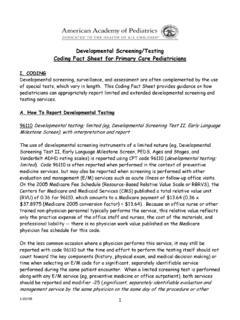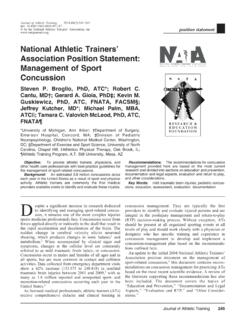Transcription of OTHER HEALTH IMPAIRMENT - arksped.k12.ar.us
1 OTHER HEALTH IMPAIRMENT . I. DEFINITION. " OTHER HEALTH IMPAIRMENT " means having limited strength, vitality or alertness, including a heightened alertness to environmental stimuli, that results in limited alertness with respect to the educational environment that is due to chronic or acute HEALTH problems such as asthma, attention deficit disorder or attention deficit hyperactivity disorder, diabetes, epilepsy, a heart condition, hemophilia, lead poisoning, leukemia, nephritis, rheumatic fever, Tourette's Syndrome, and sickle cell anemia; and adversely affects a child's educational performance. The list of chronic or acute HEALTH problems included within this definition is not exhaustive. Children with attention deficit hyperactivity disorder (ADHD) and attention deficit disorder (ADD) may be classified as eligible for services under the " OTHER HEALTH IMPAIRMENT " category in instances where the ADD/ADHD is a chronic or acute HEALTH problem that results in limited alertness, which adversely affects the child's educational performance resulting in the need for special education and related services.
2 While it is recognized that the disorders of ADD. and ADHD vary, hereafter, the term ADD will be used to encompass both disorders. II. POSSIBLE REFERRAL CHARACTERISTICS. Referral characteristics for the student with another HEALTH IMPAIRMENT (OHI) do not fall into specific intellectual, academic, behavioral, language or physical categories. Indicators of another HEALTH IMPAIRMENT may or may not be observable. The following conditions may indicate the presence of an OHI: (1) a long period of absence due to a chronic or acute HEALTH problem; (2) an inability to attend to task for the same length of time as peers due to a chronic or acute HEALTH problem; (3) an inability to attend to task as a result of medication being taken for a chronic or acute HEALTH problem; and/or (4) an inability to attend school for more than a few hours per day due to limited strength or vitality. In addition, the primary features of students with ADD include developmentally inappropriate degrees of inattention, impulsivity and overactivity.
3 III. SCREENING INFORMATION. A. Required 1. Hearing 2. Vision B. Recommended 1. Formal (Not applicable). OTHER HEALTH IMPAIRMENT . 1. 2. Informal a. Behavioral observation (Conducted in a variety of settings). b. Behavioral rating scales c. Anecdotal records d. School history (In particular, attendance). e. Parent/teacher interviews IV. REQUIRED EVALUATION DATA. A. Social History (Emphasis on developmental, HEALTH and medical). B. Individual Intelligence (One required). C. Individual Achievement (One required). D. Adaptive Behavior (One required). E. Communicative Abilities (Required as indicated below). A comprehensive language screening measure is required. Screening instruments must be established and validated for such use and assess areas of receptive and expressive language. These instruments cannot be single-word vocabulary measures only. Review of social, educational, and communication history and/or classroom observation of communicative abilities should also be utilized.
4 If the student fails the screening or if language is identified as a problem area, a diagnostic measure is required. F. OTHER 1. Medical (Required). a. Physical examination (To identify any concomitant conditions). b. Specialized, if indicated V. OPTIONAL EVALUATION DATA. These assessments are suggested for acquiring additional programming data. A. Learning Processes 1. Auditory perception 2. Visual perception 3. Perceptual-motor development OTHER HEALTH IMPAIRMENT . 2. B. Motor Development (Fine and gross motor). C. Specific Subject Areas (One in each deficit area). D. Vocational Assessment VI. EVALUATION DATA ANALYSIS. To be eligible for special education and related services under the category of " OTHER HEALTH IMPAIRMENT ," the following must be present: A. A written statement from a physician, to include: 1. The type of HEALTH IMPAIRMENT ;. 2. Any school limitations; and 3. The possible need for and effects of medication. B. Justification of the adverse affect on educational performance which is attributed to the " OTHER HEALTH IMPAIRMENT " and the corresponding need for special education and related services.
5 For most types of HEALTH impairments, a physician's diagnosis serves as the basis for classification. However, for the student with ADD a more multidisciplinary approach to diagnosis is desirable. This is particularly necessary for making a differential diagnosis, as ADD can overlap with various learning and behavior disorders. The most common of such overlaps are the conditions of specific learning disabilities and emotional disturbance. Typically, assessments for ADD. are comprehensive, involving input from both home and school, and include an evaluation of the child's medical, psychological, educational and behavioral functioning. Where ADD is combined with psychological or psychiatric disturbances, it is important to determine the relative contribution of each and how they influence each OTHER . In fact, this may lead to a classification of "emotional disturbance" rather than " OTHER HEALTH IMPAIRMENT .". The diagnosis of ADD depends on obtaining a thorough developmental and HEALTH history.
6 The developmental history and teachers' anecdotal reports and ratings about academic and behavioral problems in the classroom are important tools in the evaluation process. School-age children with ADD are described as inattentive, impulsive and/or distractible. If problem behaviors are reported by a number of different observers, started in early childhood, and have been present for more than six (6) months, it is likely that ADD is present. While physical examination does not generally contribute to the diagnosis of ADD, it is necessary in excluding OTHER medical conditions. It is generally agreed that neurological assessments (such as CAT scanning and EEGs) are not of OTHER HEALTH IMPAIRMENT . 3. benefit in diagnosing or treating ADD and should only be done when seizures or neurological findings are suggested by history and physical examination. The evaluation for ADD must rule out conditions that may produce symptoms similar to ADD. These conditions include possible medication effects, anxiety due to social/emotional factors, sensory impairments, systemic medical illness, classroom-student mismatch, seizure activity and environmental toxins (such as lead poisoning).
7 There is tremendous variation in the behavior of children with ADD. The primary symptoms are inattention, impulsivity and overactivity; however, the child may have varying manifestations of each of the characteristics and the overall severity may vary to a marked degree. Students with ADD may display deficiencies in rule-governed behavior and in maintaining a consistent pattern of work performance over time. The information obtained throughout the evaluation should provide data about the specific behaviors of concern within the school setting in order to identify intervention strategies. VII. PROGRAMMING CONSIDERATIONS. Children with an " OTHER HEALTH IMPAIRMENT " due to chronic or acute HEALTH problems often require accommodations, adaptations and/or modifications in their educational program and setting. In addition to specialized instruction, there may be a need for the provision of related services such as specialized transportation, assistive technology devices/services, school HEALTH services, parent education/training and counseling.
8 Due to the nature and extent of some HEALTH impairments, some students may need major modification of their school day including, but not limited to, rest periods, a shortened school day and/or flexible scheduling and services delivery. For students with ADD, an important element in designing the individualized education program (IEP) is addressing the student's observed, discrete behavioral and academic needs. The IEP should directly target areas for instruction in which improvement is desired, such as academic skills, social skills and classroom behavior. A behavioral management plan should be developed which deals with any disruptive and noncompliant behaviors, with an emphasis on decreasing inappropriate behaviors and increasing appropriate behaviors. While most students with ADD are learning, their problem is one of demonstrating such learning through traditional assignments and tests. Strategies which allow for variation in task presentation, rate and difficulty levels may increase active participation of the student in the learning process.
9 Additionally, these students may need assistance in the development of self-control skills, like impulse control and problem solving. OTHER HEALTH IMPAIRMENT . 4. Program design should take into account the student's need for a structured learning environment. In designing an effective intervention program, the student's teacher(s) must consider the classroom environment (seating arrangement, organization, class schedules), task demands (length, feedback, the student's participation level), classroom rules, communication and learning styles/strategies, and opportunities for generalization of appropriate behavior. OTHER HEALTH IMPAIRMENT . 5.



